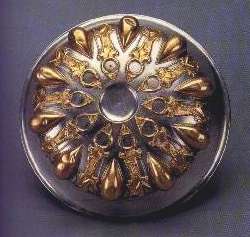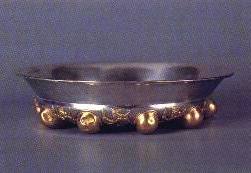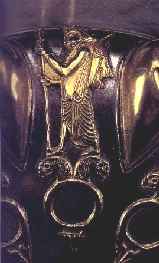

|
Silver and Gold
Height 3.6 cm.; diameter at rim 15.3 cm.
diameter of body 13 cm.
weight 245.9 gr.
Usak Museum
The shallow bowl has an offset rim, and an extremely shallow omphalos with a centring mark on the underside. The bowl itself is silver the gold decoration was made separately and applied. The ten tear-shaped lobes are hollow, slotted into grooves on the wall of the vessel, the lip around the outer edge of the groove folded and hammered down over a flange around the lobe. The same method is used for nos. 34, 36 and 37. Alternating with the lobes are ten plaques of a Persian male figure shown walking left, with one foot on each of a pair of adorsed eagle heads which surmount a ring. The figure is bearded and wears a crown. He holds before him with both hands a long spear, and he carries on his back a bow and quiven The stance and attributes are commonly seen on Persian seals. Whether such figures are to be identified as the Persian king or a hero is a question which has yet to be resolved. The motif on the pointed projection at the bottom of the rings may be a hoofed foot dmce, rather than an ivy leaf.
|
|
The hoofed foot device appears as a motif on vessels from South Russia (Maikop). D. B. Stronach has commented that the forward position of vertical pleats in the dress of the 'Persian king' is a feature of early Achaemenian art and compatible with a date in the late 6th century BC. Applied plaques of a Persian male figure, shown killing a lion, appear on the bowl no.34, and there are gold plaques of crowned Persian male figures with bow and quiver, walking fight, on a hemispherical silver bowl in the British Museum (WA 134740).
|

|











